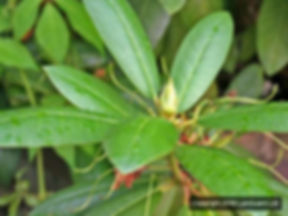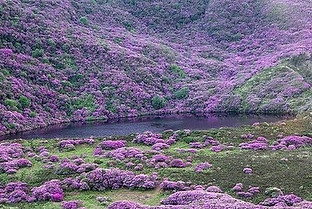

Ireland: Kerry - Dublin - Cork - Waterford - Roscommon - Galway - Belfast
UK: London - Manchester - Newcastle - Cardiff - Liverpool

Reproduction: It can reproduce by both sexual (seed) and asexual (vegetative) means. Each flower head can produce unto 7,000 seeds.
Rhododendron seeds can be dispersed by wind up to 100 metres.
It is also capable of reproducing by suckering from roots and by layering wherever branches touch the ground.

Rhododendron Flower
Rhododendron is a large perennial evergreen, acid loving shrub which is native to the Iberian Peninsula and Asia. It was introduced to Ireland during the 18th Century as an ornamental garden plant because of its attractive flowers.
There are over 900 species of Rhododendron, but only Rhododendron ponticum is invasive in Ireland.
Since its introduction, Rhododendron has escaped into the wild and is particularly invasive in the west, north-west and south-west of the country. Rhododendron thrives on acidic soil in areas with mild, moist climatic conditions.
It can colonise a range of habitats including agricultural land, grasslands, woodland, urban areas, roadsides and wastelands
How To Identify Rhododendron?
Flower: Purple flower
Leaf: Deep green waxy leaf
Stem: Woody and tangled


Rhododendron invasive stand

Rhododendron - Rhododendron ponticum ID Guide
Rhododendron leaf
Why Is Rhododendron A Problem?
Rhododendron is an aggressive coloniser which is both environmentally and ecologically damaging to infected sites.
Once established, it forms dense, long-lived thickets which smother the ground flora and suppress the regeneration of native trees and shrubs. Its dense thickets can reach several metres in height.
Well established thickets eventually form a toxic layer of leaf litter which produces a dark sterile environment and supports little wildlife.
The foliage of Rhododendron is unpalatable to grazing animals. Dense tangles of Rhododendron stems can block pathways, smother watercourses and encroach on roadways, resulting in an impingement of sight- lines.
In some cases, infestations have been so expensive to control that land has been abandoned.
Rhododendron - Invasive Species Information
What Is Rhododendron - (Rhododendron ponticum)?
Habitat: Terrestrial
Distribution in Ireland: Extensive
Status: Established
Family name: Ericaceae
European Communities (Birds and Natural Habitats) Regulations 2011 non-native invasive plant species A-Z (Updated 2017)
There are currently 35 invasive plant species listed in the European Communities (Birds and Natural Habitats) Regulations (annex 2, Part 1)...
Click on a species from the following list to find out more regarding non-native species subject to restrictions under Regulations 49 and 50.
-
American Skunk-Cabbage - Lysichiton americanus
-
Red Alga - Grateloupia doryphora
-
Waterweeds - Elodea (all species)

